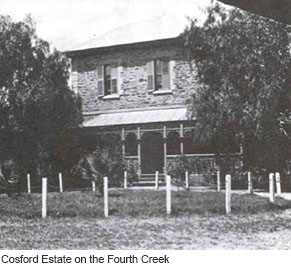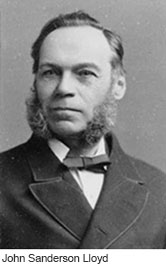Cosford Estate
William Henry Neale
William Henry Neale came to South Australia aboard the “Cygnet” in 1836 along with his wife and five children.1 A sixth child, a son, was born at Nepean Bay (Kangaroo Island) on the 13th of September 1836, not long after their arrival in the Colony. The newborn became ill and two months later he died after being taken to Holdfast Bay (Glenelg). William believed this child was the first born in South Australia.2 He and his wife Mary Elizabeth (Nee Young) had two more children, Charlotte Catherine, born in Adelaide 11th June 1838 and Rose Helen, born at Fourth Creek on 6th February 1841. An auctioneer by profession, he was declared insolvent on July 16th 1853.3 William Henry Neale died on May 9th 1886 at Echuca and is buried in Bendigo Victoria.
Price Maurice
The new owner of Fourth Creek was Price Maurice. In 1849 he built a two story house on the estate, next door to the cottage that had been home to the Neale family. He also owned a large property at Castambul.
 Price Maurice had the largest flock of Angora Goats of anywhere in the continent. He also had properties at Pekina and Oladdie the combined area of each was around 671 sq. miles. On these properties the greatest number of sheep shorn in one year was 118,000 yielding 2,003 bales of wool. He also leased the Warrow, Lake Hamillton Run and the Bramfield Run, on the Port Lincoln Peninsula. The size of these properties was a further 943sq. miles.
Price Maurice had the largest flock of Angora Goats of anywhere in the continent. He also had properties at Pekina and Oladdie the combined area of each was around 671 sq. miles. On these properties the greatest number of sheep shorn in one year was 118,000 yielding 2,003 bales of wool. He also leased the Warrow, Lake Hamillton Run and the Bramfield Run, on the Port Lincoln Peninsula. The size of these properties was a further 943sq. miles.
Holding a further 97,000 sheep producing 1,553 bales of wool.4 The administration of some of these properties, particularly those in the North of South Australia caused him serious health problems, and was instrumental in his returning to England to regain his health.5 A manager and his son were left to look after his interests in South Australia. He was never to return. It was to be another decade and a half before George Goyder was to provide information on the lack of rainfall north of his Goyder’s Line. To this day Goyder’s Line denotes areas of poor rainfall not suitable for cropping or grazing. The death of Price Maurice was announced in 1894 in England.
John Hawkins
In 1864 John Hawkins bought part of the estate on Fourth Creek including the two story house, which he named “Cosford.” He moved in with his wife Anna and five children. After only a few months Anna was killed in a horse riding accident.6 Two years later John Hawkins died, leaving five children three under 21 years of age. In his will, that had been poorly worded, his three children (under 21) were to be looked after by the sale of the estate. The will was contested by the Attorney General on behalf of the children under 21. The outcome of the court case was, that the property was to be leased and the income to be shared by the three minors. It could not be sold until after the last child had attained the age of 21, or had married prior to reaching that age.7 A cash settlement was to be given if any child married before 21 years. This ruling was by the Chief Justice of South Australia. The Cosford estate was leased to George and Alfred Ward until the last daughter attained the age of 21 years. This occurred in 1876 and the property then sold as per John Hawkins will.
John Sanderson Lloyd
 The new owner J.S.Lloyd was born in Kendal Westmoreland in 1831. He was the son of Isaac Lloyd a Bristol banker and a member of a well known Birmingham family. He left England aged 22 in the Barque “Harriett Humble” to join his cousin Mr. E.H. Fox in the business of merchant and importer at their office in Grenfell St. Adelaide. In 1856 he married Charlotte Emily eldest daughter of the late Mr. Henry Watson. The brother of J.S. Lloyd was Mr Howard Lloyd of Bromsgrove. Worcestershire and he was the General Manager of Lloyd’s the renowned English Bank.8 An accountant J.S. Lloyd was employed by Messrs Elder, Stirling & Co. When the company became Elder, Smith & Company he remained as principle accountant for 32 years. He then became the auditor of the company and also the auditor of the South Australia Company and the Bank of Adelaide.9 He tried to lease Cosford House and land but was unsuccessful. He then decided to sell it in its entirety. That was also unsuccessful, so in the end it was split up and sold in parcels. The house was sold with enough land to earn an income and the remainder in two lots of an orangery and a vineyard. J.S. Lloyd died in September 1914 aged 83 at his home in North Adelaide.
The new owner J.S.Lloyd was born in Kendal Westmoreland in 1831. He was the son of Isaac Lloyd a Bristol banker and a member of a well known Birmingham family. He left England aged 22 in the Barque “Harriett Humble” to join his cousin Mr. E.H. Fox in the business of merchant and importer at their office in Grenfell St. Adelaide. In 1856 he married Charlotte Emily eldest daughter of the late Mr. Henry Watson. The brother of J.S. Lloyd was Mr Howard Lloyd of Bromsgrove. Worcestershire and he was the General Manager of Lloyd’s the renowned English Bank.8 An accountant J.S. Lloyd was employed by Messrs Elder, Stirling & Co. When the company became Elder, Smith & Company he remained as principle accountant for 32 years. He then became the auditor of the company and also the auditor of the South Australia Company and the Bank of Adelaide.9 He tried to lease Cosford House and land but was unsuccessful. He then decided to sell it in its entirety. That was also unsuccessful, so in the end it was split up and sold in parcels. The house was sold with enough land to earn an income and the remainder in two lots of an orangery and a vineyard. J.S. Lloyd died in September 1914 aged 83 at his home in North Adelaide.
[Image to the right: State Library of South Australia Adelaide Book Society : J.S. Lloyd [B 22103/83]]
James Todman MD
The next owner of Cosford House was James Todman MD. He came to South Australia on a migration ship in 1852. He was employed as the Surgeon Superintendent on that vessel. He studied medicine in Edinburgh and the University of Adelaide. He met and married Cecilia Olliver here in Adelaide. His first practice was at Port Adelaide then Magill, Port Elliot, back to Port Adelaide and finally at Moonta Mines. He died in Moonta in 1878 from a heart condition at 60 years of age.
Thomas Binns Robson
Born in Lifecard Vale Cheshire Thomas Binns Robson married a South Australian girl, Miss Henrietta Watson who had gone to England, where they married in March 1871. Henrietta Watson was the sister of Charlotte Emily Watson who was married to John Sanderson Lloyd a previous owner of Cosford House.10
The Robsons both arrived in Adelaide aboard the Barque “Corrientes” in August 1871.11 Shortly after arriving they bought and settled on an Estate in Hectorville. They called it Ellythorpe after his father Henry Ellythorpe Robson of Wirral in Cheshire. He planted trees and set up a dried fig industry there. He introduced the fig wasp into South Australia, which was essential to pollinate the Smyrna and Capri figs used in his industry.12 In 1905 he imported figs with the wasp larvae in them from California. The trees grew and prospered but the larvae died because of cold weather. In 1909 he again imported figs and larvae from South Africa. This time it was successful.
Ellythorpe Estate was next door to Cosford Estate, so when it came up for sale in 1908 he purchased it. He moved in to Cosford House and his son Henry Binns Robson remained at Ellythorpe.
They continued to expand their fruit growing and dried fruit processing industry. Thomas Robson says he remembers when Mr. Price Maurice owned the property and it was a huge sheep run, covering a huge part of the Adelaide Hills. The front garden (which is now the back garden) was trenched to bring the clay soil to the top. This was the general practice of Englishmen in the early days. This poor practice made it the least productive part of the estate.13
Mr. Thomas Binns Robson died in 1923. His son Henry remained at Ellythorpe and his daughter Mrs. Mary Bedford and his other son Walter Binns Robson moved into Cosford House.14
Walter Binns Robson
Mary Bedford died 5th October 1926
H.B. Robson
The family fruit growing and processing business continued to expand. A commercial processing plant was built on the estate at Hectorville. The Company was called Robson Jarvis & Co. Charles Binns Robson a grandson of the founder was the last descendant when the company ceased trading in the mid 1950’s.
Researched and compiled by Jim Nelson, a volunteer with the Campbelltown Library “Digital Diggers” group.
If you have any comments or questions regarding the information in this local history article, please contact the Local History officer on 8366 9357 or hthiselton@campbelltown.sa.gov.au
References
- https://bound-for-south-australia.collections.slsa.sa.gov.au/1836Cygnet.htm
- Bendigo Advertiser 11th May 1886 p3
- Adelaide Observer Saturday 16 July 1853 p 8
- South Australian Register Tuesday 15 May 1894 p 5
- South Australian Register Tuesday 15 May 1894 p 5
- Adelaide Observer Saturday 29 October 1864 p 3
- South Australian Register 6th March 1867 p 3
- Observer (Adelaide, SA : 1905 - 1931) Saturday 19 September 1914 p 23
- Observer (Adelaide, SA : 1905 - 1931) Saturday 19 September 1914 p 23
- http://sant.quakers.org.au/walkingcheerfully/2014/2014_03 (no longer available online)
- The Advertiser (Adelaide, SA : 1889 - 1931) Thursday 23 April 1925 p 13
- News (Adelaide, SA : 1923 - 1954) Friday 24 April 1925 p 5
- Renmark Pioneer (SA : 1892 - 1913) Friday 7 July 1911 p 4
- The Advertiser (Adelaide, SA : 1889 - 1931) Thursday 23 April 1925 p 13
